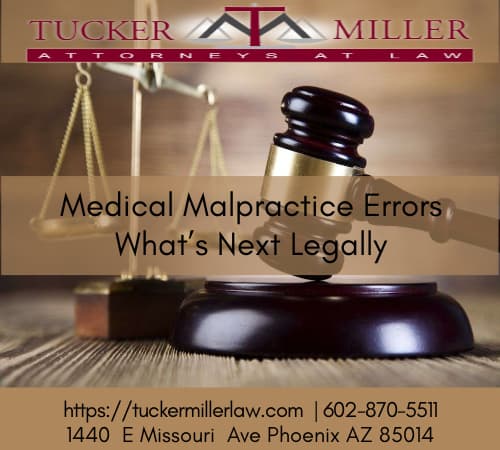Medical Malpractice
Common Medical Malpractice Errors 101
On This Page
- Medical Malpractice Errors What’s Next Legally
- Medical Devices and Products Liability Cases
- Medical Devices Medical Malpractice Physician Vs Third Party
- For Every One Medical Malpractice Lawsuit, 7.6 Patients Are Injured by Doctor Error
- What Must Take Place To Constitute Medical Malpractice
- How Do I Know If I Have Been The Victim Of Medical Negligence?
- What Are The Most Common Forms Of Medical Negligence?
- What Can Be Done About Medical Negligence?
- Medical Malpractice Delay In Diagnosis of Stroke
Medical Malpractice Errors What’s Next Legally
The cases that can lead to a medical malpractice lawsuit are many and varied, as there are a huge variety of ways for a doctor to be negligent.
In no particular order, the following are types of the most common medical malpractice claims:
- Misdiagnosis or delayed diagnosis.
- Failure to treat.
- Prescription drug errors.
- Surgical or procedural errors.
- Childbirth injuries.
You might be shocked to learn that medical errors are the third leading cause of death in the U.S., according to Johns Hopkins. This accounts for nearly 250,000 deaths a year, although the Journal of Patient Safety claims that this number could be as high as 450,000.
For example, if a doctor failed to inform a patient of the risks of a certain surgical procedure, they failed their duty of informed consent. In other words, if a patient would have elected not to go through with a procedure once informed of the risks, the doctor may be liable if the patient is injured during that procedure.
Medical malpractice law- In common law jurisdictions, medical malpractice liability is normally based on the laws of negligence. Although the laws of medical malpractice differ significantly between nations, as a broad general rule liability follows when a health care practitioner does not show a fair, reasonable and competent degree of skill when providing medical care to a patient. If a practitioner holds himself out as a specialist a higher degree of skill is required. Jurisdictions have also been increasingly receptive to claims based on informed consent, raised by patients who allege that they were not adequately informed of the risks of medical procedures before agreeing to treatment.
There are many examples. Certainly more than we can talk about here, but a real common type of malpractice case is a failure to diagnose. Think of a cancer case. A woman will go to a doctor with a breast lump and the doctor will diagnosis a cyst and it turns out in retrospect that truly was a breast cancer. And the delay in diagnosing the breast cancer has a negative impact on the patient’s prognosis. Now, sometimes a misdiagnosis can result in a medical malpractice lawsuit. Think of the example of a patient who goes to a doctor with cold symptoms. The doctor may think well, this is bronchitis and it turns out that it was truly pneumonia and a chest x-ray was not done and the patient subsequently dies. Another type of malpractice is a surgical error. We have had cases where the wrong side of the patient’s body was operated on or a blood vessel is injured during surgery or a nerve is injured during surgery. Getting an infection in the hospital can be malpractice if proper sterile techniques were not followed in the hospital. In an infection case, often times infections are not promptly diagnosed and treated. Another common type of medical malpractice case deals with medication errors. Sometimes you will get the wrong medication or the wrong dose. Those are the big areas of medical malpractice.

Medical Devices and Products Liability Cases
A product liability case can arise from injuries caused by defective or dangerous medical appliances, equipment, organ transplants, prosthetic devices, surgical implants, surgical equipment, hospital supplies, diagnostic equipment, and hearing and visual aids. Any of these products can be the subject of a products liability lawsuit if the cause injury to a patient. First concern: statute of limitations
one of the major concerns in cases of this nature is the statute of limitations (the time limit for bringing a lawsuit). All states allow a fixed period of time in which to bring a suit, but in many cases involving defective medical products a significant period of time can elapse between a patient’s exposure to a defective product and the patient’s awareness of the injury. Because of that problem, many states have adopted a discovery rule, under which the time limit for bringing suit does not begin to run at the time of the injury, but rather when the injured person knows or should have become aware of the resulting illness or other damage.
With the rise of healthcare costs and recent news surrounding medical device failures might give you pause after your doctor recommends the use of a particular instrument for surgery or care. This article will you help you understand the particular aspect of medical issues in the overall products liability scheme. Before anything else, it is important to understand who the possible responsible party could be. When trying to figure this out just remember who treated you or who gave you services, treatments, devices, prescriptions, or even recommendations?
In previous articles we have discussed the evolution of federal preemption for state products liability claims against medical device manufacturers. This is a controversial approach, and federal district and appeals courts have made opposing ruling on cases that are legally identical. Some courts have refused to allow any products liability claims for devices, some have limited claims against only some devices, and some courts refused to limit claims in any cases. The united states supreme court has now reviewed this law to resolve the conflicts.

Medical Devices Medical Malpractice Physician Vs Third Party
Not all medical devices are implants. The majority of medical devices in a hospital are used for diagnostics and testing purposes. Some medical devices assist in surgical procedures
When any of these medical devices produce bad or incorrect information, it leads to bad decisions. Bad decisions result in injury and grind years off a patient’s life and well-being.
Manufacturers of medical devices bear a responsibility to craft devices to specifications and according to regulations. When they cut corners in terms of materials, quality control, or production speeds, they put the public at risk.
Implanted devices need to work hold up for their specified lifecycle to avoid patients requiring additional surgeries for removing and implanting. They also need to avoid degrading and deteriorating. It doesn’t take much in the way of foreign materials floating in the body to cause major issues.
If complications occur due to issues with a surgically implanted medical device, the product manufacturer may actually be at fault. In fact, certain devices carry an unnecessary high risk of injury in patients. Two notable examples of devices that have caused serious patient injury include: metal hip implants, and inferior vena cava filters for blood clots.
Medical devices may be eligible for product liability claims, if found defective in its manufacturing process, design or marketing strategy.
- Defectively manufactured medical devices improperly fabricated or damaged/comprised in some way during the manufacturing process. However, the defect or damage could have occurred at any point between the manufacturing facility to the place you received the device.
- Defectively designed medical devices properly manufactured, but the design itself poses an unreasonable danger that could result in injury. These defects not due to an error or mishap during the manufacturing process but arise because the entire line of products is inherently dangerous.
- Defectively marketed medical devices involve failure-to-warn claims. While the device manufactured properly and was not considered inherently dangerous, an injury occurred because the patient was not provided with adequate or accurate warnings about the potential danger posed by the device or given adequate instructions about the safe and appropriate use of the device.

For Every Medical Malpractice Lawsuit, 7.6 Patients Are Injured by Doctor Error
For medical negligence claims, the statute of limitations in Arizona is generally two years. This means that an injured person must file a lawsuit against a doctor or other medical provider within two years from the date of the surgical error, or else he or she usually will be barred from pursuing compensation. There are a few limited exceptions to this general rule. The first involves situations in which the patient did not, despite reasonable efforts, discover the malpractice until after the two-year period. A “statute of repose” is then triggered, and the claimant may be able to file suit up to four years from the date of the act of malpractice. There are also statute of limitations exceptions for children and certain other persons who lack the legal capacity to sue due to a disability.
The breach by a member of a profession of either a standard of care or a standard of conduct. Malpractice refers to negligence or misconduct by a professional person, such as a lawyer, a doctor, a dentist, or an accountant. The failure to meet a standard of care or standard of conduct that is recognized by a profession reaches the level of malpractice when a client or patient is injured or damaged because of error. After the 1970s the number of malpractice suits filed against professionals greatly increased. Most malpractice suits involved doctors, especially surgeons and other specialists who performed medical procedures with a high degree of risk to their patients. Large damage awards against doctors resulted in higher malpractice insurance costs. Similarly, the increase of malpractice awards against lawyers led to higher insurance premiums and caused some insurance companies to stop writing malpractice policies altogether.
According to the article “ten common but preventable errors,” by melanie haiken every year 1. 5 million people are sickened or severely injured by medication mistakes and 100,000 people die. These errors are mistakes and are “avoidable” medical errors. If a doctor makes a mistake when prescribing a medication or there is a medical mistake due to the medication prescribed, you may have means for a medical malpractice lawsuit.

What Must Take Place To Constitute Medical Malpractice
Medical malpractice occurs when a hospital, doctor or other health care professional, through a negligent act or omission, causes an injury to a patient. The negligence might be the result of errors in diagnosis, treatment, aftercare or health management.
To be considered medical malpractice under the law, the claim must have the following characteristics:
- A violation of the standard of care – The law acknowledges that there are certain medical standards that are recognized by the profession as being acceptable medical treatment by reasonably prudent health care professionals under like or similar circumstances. This is known as the standard of care. A patient has the right to expect that health care professionals will deliver care that is consistent with these standards. If it is determined that the standard of care has not been met, then negligence may be established.
- An injury was caused by the negligence – For a medical malpractice claim to be valid, it is not sufficient that a health care professional simply violated the standard of care. The patient must also prove he or she sustained an injury that would not have occurred in the absence of negligence. An unfavorable outcome by itself is not malpractice. The patient must prove that the negligence caused the injury. If there is an injury without negligence or negligence that did not cause an injury, there is no case.
- The injury resulted in significant damages – Medical malpractice lawsuits are extremely expensive to litigate, frequently requiring testimony of numerous medical experts and countless hours of deposition testimony. For a case to be viable, the patient must show that significant damages resulted from an injury received due to the medical negligence. If the damages are small, the cost of pursuing the case might be greater than the eventual recovery. To pursue a medical malpractice claim, the patient must show that the injury resulted in disability, loss of income, unusual pain, suffering and hardship, or significant past and future medical bills.

How Do I Know If I Have Been The Victim Of Medical Negligence?
If you are the victim of a surgical error, physician negligence or another form of medical malpractice, you may not know where to turn to for help. You may have had to undergo further surgical operations or other painful treatments as a result of a physician’s mistake. A personal injury attorney in Arizona may be helpful in answering any questions you may have regarding your case and could help point you in the right direction.

Hire Top Defective Medical Device Malpractice Phoenix Attorneys
The experienced defective medical device attorneys at Tucker and Miller can help you get the compensation you deserve. We offer free consultations, and our legal team accepts most defective medical device claims on a contingency basis. This means you only pay a fee when we win your case. Visit our office from 8 AM to 5 PM or call us anytime at 602-870-5511 to discuss your claim today!
Nerve damage is a common injury sustained by victims of auto accidents, dog bites and cases of medical negligence including surgical medical malpractice. One of the most frequent questions asked by victims of severe nerve damage during consultations with our attorneys is, “how much my case is worth,” or “what the value of my case?” the estimated value of a personal injury case is dependent on numerous factors unique to the individual harmed. Only a qualified personal injury attorney who can investigate the facts of your case will be able to determine the estimated value of your claim. There is no financial cap on medical Malpractice cases in Arizona.
One of the biggest issues in medical malpractice law is the issue of medical negligence. Medical negligence is defined as a situation where a medical professional has neglected their duty of care to the patient and has actively or passively caused harm to the patient as a result of their negligence.

What are the most common forms of medical negligence?
Medical malpractice law in the united states is derived from english common law, and was developed by rulings in various state courts. Medical malpractice lawsuits are a relatively common occurrence in the united states. The legal system is designed to encourage extensive discovery and negotiations between adversarial parties with the goal of resolving the dispute without going to jury trial. The injured patient must show that the physician acted negligently in rendering care, and that such negligence resulted in injury. To do so, four legal elements must be proven: (1) a professional duty owed to the patient; (2) breach of such duty; (3) injury caused by the breach; and (4) resulting damages. Money damages, if awarded, typically take into account both actual economic loss and non economic loss, such as pain and suffering.
In a new The Institute of Medicine Report emphasized that patients need to take more responsibility for their own medication education and self-management. The american college of emergency physicians provides medical forms to consumers to pass along information to emergency physicians in case of an emergency. The report stated that errors cause between 44 000 and 98 000 deaths every year in American hospitals, and over one million injuries. Health care appeared to be far behind other high risk industries in ensuring basic safety. The IOM report called for a 50% reduction in medical errors over 5 years.
Each year hundreds of medical negligence claims are filed in Arizona. The most common reason for these are errors in diagnosing an illness or injury. Mistakes related to surgeries of all types are a close second as they account for 32% of medical malpractice cases. Some surgeries are common, minimally invasive and yet others are very rare but they can all end in injury, permanent impairment and wrongful death. Surgical procedures that frequently end in malpractice are gastric bypass surgery, bariatric surgery, breast augmentation, colon and rectal surgery, heart surgery, endocrine surgery, hernia surgery, lung surgery, liposuction, neurosurgery, laparoscopic surgery, varicose vein surgery, hysterectomies, abdominoplasties and coronary artery stent placement.

What can be done about medical negligence?
A medical malpractice victim often suffers additional injuries, or their condition grows much worse because of a medical provider’s negligence and wrongdoing. If you are injured because of a doctor’s medical malpractice, you deserve to be compensated fully for your damages. Contact the medical malpractice attorneys at Tucker Miller law today. Our Arizona medical malpractice attorneys can help you seek the maximum compensation available for your claim. People who retain the right attorney receive up to 3x more compensation than those who do not.
This law usually enables people who have been injured by another party’s negligence to recover compensation for the injuries and losses caused by that at fault party. The damages mainly include past and future medical bills, property damage, lost wages, pain, suffering, and loss of enjoyment of life. There are several types of personal injury case types in Arizona. These include automobile crashes, medical malpractice, failure to diagnose Heart Attack, failure to diagnose Cancer, Orthopedic surgical error, Neurosurgical error, commercial truck accidents and wrongful death cases.
Hospitals make money from mistakes because insurers pay them for the longer stays and extra care that patients need to treat preventable surgical complications, according to a study published in the journal of the american medical association. Authored by experts from harvard’s medical school, the boston consulting group, the 2010 study is based on a detailed analysis of 34,256 surgery patient records from 12 hospitals. The report indicates that the current payment system makes it difficult for hospitals to improve safety because the cost of improvements is greater than the cost of liability and surgical negligence lawsuits.

Medical Malpractice Delay In Diagnosis of Stroke
The Tucker Miller law group is an Phoenix personal injury law firm that has been helping victims of medical malpractice in Arizona for over thirty five years. Among those cases, are victims of a delay in diagnosis of stroke. According to research conducted by physicians from the department of neurology medicine and emergency medicine at yale university, the failure to recognize an ischemic stroke in the emergency department is a missed opportunity for acute interventions and prompt treatment with secondary prevention therapy. Their study examined the diagnosis of acute ischemic stroke in the emergency department of an academic teaching hospital and a large community hospital. The current guidelines recommend intravenous recombinant tissue-type plasminogen (tpa) within about 4 hours in select patients. Patients that have large vessel occlusion may benefit from early recanalization with stent-retrieval devices. Also, patients with missed strokes may not be monitored appropriately for the neurological progression of stroke syndromes or stroke-related complications. There are many forms of compensation for medical malpractice victims, which include lost wages, payment of medical bills, pain, and suffering, and more. You can learn more about your options by contacting our medical malpractice lawyer.












